Kayak Competition (Locations & Calendar)

Since the first kayaks, paddlers have been eager to prove their skills on the water and find out who among them was faster, quicker in the turns, or a better hunter.
It’s just human nature to want to compete and find out who’s the best, going back to the original Olympic games in ancient Greece.
It’s no different today. There are two kayaking and canoeing competitions in today’s Summer Olympic games. One is the Canoe Slalom, and the other is the Canoe Sprint. And there are also several non-Olympic kayaking competitions, such as wild water, river racing, surf competitions, and even dragon boat racing.
All involve paddlers of various skill levels competing to find out who’s the best — for pride, fun, and sometimes even for cash prizes.
Here’s a Quick List Of The Most Popular Competitions Out There
| Competition | Location | Type of Competition | Notable Facts |
|---|---|---|---|
| Olympic Kayaking | Varies (Olympic host city) | Sprint and Slalom | Considered the ultimate challenge in extreme kayaking, the Sickline Championship combines a time-trial format with head-to-head racing. The race course, known as the “Wellerbrücke” rapids, is renowned for its demanding and technical nature. |
| ICF Canoe Sprint World Championships | Varies | Sprint | Organized by the International Canoe Federation (ICF) since 1970, this competition brings together the world’s top sprint kayakers. It is held annually, except in Olympic years. |
| The Devizes to Westminster International Canoe Marathon | United Kingdom | Marathon (Endurance) | The Devizes to Westminster International Canoe Marathon is a challenging long-distance race that covers a 125-mile course from Devizes in Wiltshire to Westminster in London. This iconic event attracts paddlers from around the world and tests their endurance, navigation skills, and teamwork. |
| The Adidas Sickline Extreme Kayak World Championship | Ötztaler Ache River, Austria | Extreme Whitewater | The Devizes to Westminster International Canoe Marathon is a challenging long-distance race that covers a 125-mile course from Devizes in Wiltshire to Westminster in London. This iconic event attracts paddlers worldwide and tests their endurance, navigation skills, and teamwork. |
| ICF Canoe Slalom World Championships | Varies | Slalom | Also organized by the ICF, the Canoe Slalom World Championships showcase the best in slalom kayaking. The event includes different classes, such as K1, C1, and C2, for both men and women. |
| Yukon River Quest | Yukon River, Canada | Marathon (Endurance) | The “Race to the Midnight Sun” is the worth annual canoe and kayak race, spanning 444 miles (715 kilometers) from Whitehorse to Dawson City in Canada’s Yukon Territory. |
| Competition | Location | Type of Competition | Notable Facts |
|---|---|---|---|
| The Texas Water Safari | Texas, USA | Marathon (Endurance) | The largest paddling event in New England and one of the largest in the U.S. covers 16.5 miles (26.5 km) of various water conditions. |
| Green Race | Green River, North Carolina, USA | Whitewater (Extreme) | This is one of the most challenging whitewater races in the United States. Competitors navigate through class V rapids in a race against the clock. |
| Coast to Coast Race | South Island, New Zealand | Multisport | This is a multisport competition that includes a significant kayaking section. Competitors traverse the width of New Zealand’s South Island, crossing the Southern Alps. |
| The Kenduskeag Stream Canoe Race | Kenduskeag Stream, Maine, USA | Whitewater | Avon and Swan Rivers, Western Australia |
| The Hawkesbury Canoe Classic | Hawkesbury River, New South Wales, Australia | Marathon (Endurance) | An annual 111 km overnight canoe race that raises funds for charity. It is known for the camaraderie and spirit of the participants. |
| Avon Descent | Avon and Swan rivers, Western Australia | Whitewater (Endurance) | A two-day, 124 km race covering tranquil pools, rolling rapids, and torrential whitewater. It’s known as one of Australia’s most challenging river races. |
Introduction
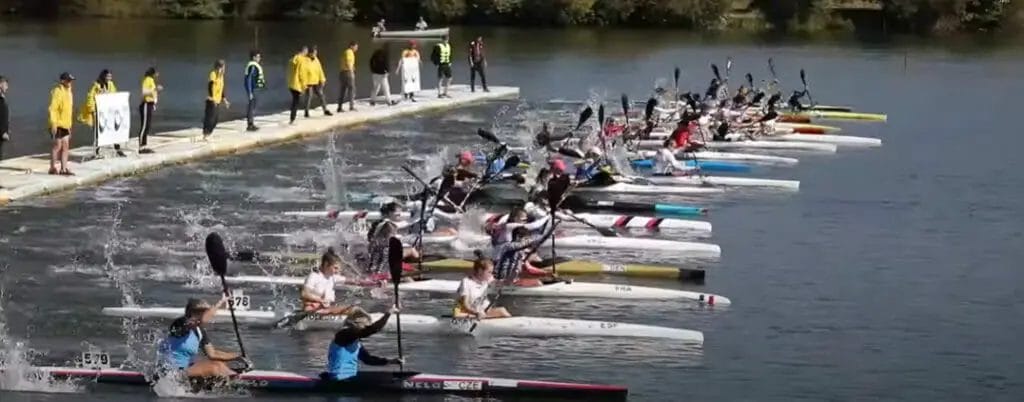
Brief history and development of the sport
The 20th century—that’s when the magic happened. Picture this: it’s 1924, you’re in the heart of Paris and bam! Flatwater kayak racing makes its grand debut at the Olympics. Fast-forward a dozen years, and we’re in Berlin in 1936, where kayaking officially gets its spot on the Olympic roster. Then, in 1972, the daredevils of slalom kayaking crashed the Olympic party.
And now, in our modern world, kayaking isn’t just one sport—it’s a whole array of thrilling disciplines. From whitewater and sea kayaking to surf, freestyle, sprint, and slalom, there’s something for everyone, each with its unique gear and rules.
The International Canoe Federation (ICF), our global kayaking HQ, oversees all this excitement. They set the rules and standards and keep things running smoothly, with World Championships that dazzle us year after year.
Importance and popularity of Kayak Competitions globally
Kayak competitions have transformed this once tranquil pastime into a global sporting event. Race and spectacles include the ICF Canoe Sprint World Championships, the Devizes to Westminster International Canoe Marathon, or the Adidas Sickline Extreme Kayak World Championship. They draw audiences and competitors from all corners of the globe, proving that the love for this sport transcends borders and cultures.
But it’s not just about the competitive spirit. These events also encourage people to embrace the outdoors, understand the importance of preserving our natural waterways, and foster a sense of community among outdoor enthusiasts.
And here’s the kicker: with each passing year, the sport grows, drawing more participants, spectators, and coverage. Why in some countries, kayaking competitions are as eagerly awaited as the Super Bowl!
Types of Kayak Competitions

Whitewater kayaking

This discipline stands apart from the rest in kayak competitions, and let me tell you why.
First off, whitewater is a whole different beast compared to calm waters. We’re talking fast-moving river currents, turbulent water, and hidden obstacles. You’ll encounter waves that look like they’re on a mission, holes that suck you in, and maybe even a waterfall or two. It’s not for the faint-hearted, folks. Whitewater kayaking competitions happen in this natural, untamed environment, adding unpredictability not usually present in other kayaking events.
The essence of these competitions? Speed, technique, and precision. Kayakers hurl themselves downriver, navigating through rapids and around rocks while keeping their eyes on the prize. The objective can be to finish a course quickly, like in a downriver race, or to perform spectacular stunts, like in freestyle competitions.
In slalom events, kayakers must maneuver through a series of hanging gates without missing or touching any while battling the fierce current.
Whitewater kayaking differs from other types of kayak competitions, like sea or sprint kayaking, because of its variety. Sea kayaking is generally about long-distance endurance and navigation in vast open waters, while sprint kayaking is all about speed in a straight line on calm water. On the other hand, whitewater kayaking requires athletes to have a wide range of skills.
From the ability to read and react to rapid water movements to performing complex maneuvers under pressure and having the strength and endurance to power through a course—it’s all part and parcel of the sport.
Another aspect that sets whitewater competitions apart is the equipment. Whitewater kayaks are generally smaller, sturdier, and more maneuverable, designed to handle rapids’ capricious nature and allow quick, sharp turns.
Freestyle Kayaking
Whether you call it playboating, rodeo, or freestyle kayaking, this is the most artistic and gymnastic of the various forms of competitive paddling.
Unlike other competitive kayaking varieties, playboating doesn’t involve moving from point A to point B, and the paddler isn’t racing against another paddler or trying to beat a specific time to win the competition.
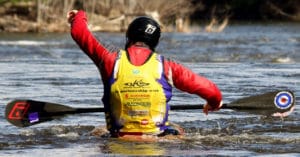
With this type of freestyle or rodeo boating, the paddler stays in a specific spot on the river and uses a dynamic feature such as a wave or pour-over to perform various acrobatic stunts and maneuvers.
In this form of competition, the paddler will be in a “playboat,” a very short and stubby, low-volume whitewater kayak that is easy to spin, roll, cartwheel, surf, and perform aerial loops and a variety of other tricks.
Since freestyle kayakers aren’t racing against each other, a set of nearby judges rates each paddler as they perform their maneuvers and gives them a numbered score to decide on a competition winner. These types of competitive events in the US are usually referred to as “whitewater rodeos,” In Europe and other parts of the world, they’re known as freestyle events.
Sprint Kayaking
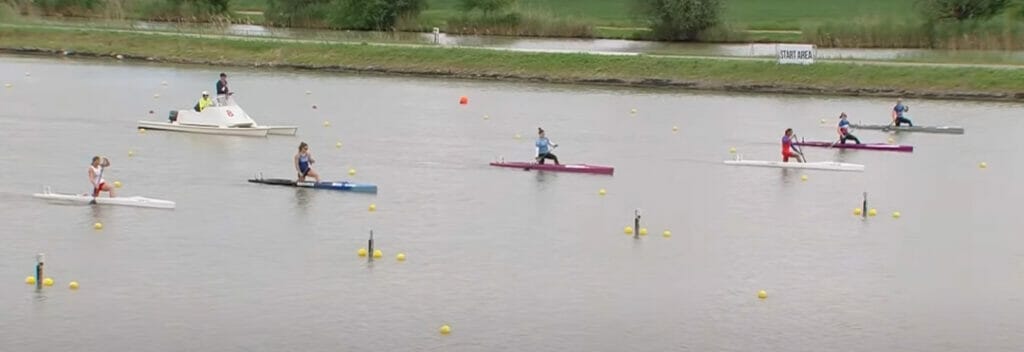
Sprint kayaking, or flatwater racing, is a pulse-pounding speed, strength, and precision test.
Unlike the unpredictability of whitewater or sea kayaking competitions, sprint kayaking competitions occur on flat, calm water—usually on a straight course in a lake or a calm river. But don’t let the tranquility fool you. The battles that unfold on these peaceful waters are anything but tranquil.
The races are straightforward but far from simple. Athletes line up at the start, and when the signal is given, they power through the water, paddling with all their might to reach the finish line in the shortest time possible. There’s no navigation around buoys, tricks, or obstacles—just an all-out sprint to the finish.
Distances vary in these competitions. Common race distances include 200 meters, 500 meters, and 1000 meters, each requiring a different blend of speed, power, and pacing. And while it’s a solo sport, there’s a real sense of camaraderie here, with team events like K2 (two paddlers in the kayak) and K4 (four paddlers) adding another layer of strategy and synchronization to the mix.
The design of sprint kayaks is also a factor that sets this discipline apart. These are slim, lightweight, and incredibly aerodynamic boats built for one thing: unadulterated speed. Stability takes a backseat here—the focus is on minimizing water resistance to maximize speed.
Slalom Kayaking
Slalom racing, also known as whitewater slalom, is probably the most popular form of competitive kayaking. Slalom kayaking is similar to slalom skiing in that the participants race both downstream and upstream as fast as they can while at the same time navigating through a series of gates placed strategically along the course.
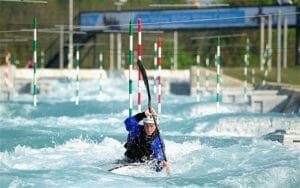
The best slalom paddlers combine strength, precision, grace, and calmness under pressure. This is a sport where fast reflexes, and the ability to make lightning-quick decisions, can make the difference between winning and finishing in second place.
In the case of slalom kayaking, the numbered gates that the competitors are required to navigate are poles suspended from cables above the water. The objective is to go through the gates — white and red are passed through while going downstream, white and green are passed through upstream – without touching them with any part of your equipment or body.
The paddler is racing against the clock in this competition. Each is given three runs – the first is a time trial, and the last two are timed runs. The fastest two runs are counted toward that paddler’s final score. Then when all the paddlers are finished, the one with the fastest timed run is declared the winner.
Rules and Regulations of Kayak Competitions

Let’s switch gears here and dive into the rules and regulations of kayak competitions.
- Safety: Above all else, the safety of the participants is paramount. All kayakers must wear appropriate safety gear, typically including a life jacket or personal flotation device (PFD), helmet (especially for whitewater and slalom kayaking), and suitable clothing for the weather and water conditions.
- Equipment: The kayak and other equipment, such as the paddle, must meet the specifications outlined by the competition’s rules. This can include requirements for the length, weight, and type of kayak and regulations regarding modifications.
- Conduct: Respectful and sportsmanlike conduct is expected from all participants. This includes showing respect for other competitors, officials, and the environment.
- Starting Procedure: Races usually start with a signal from an official. False starts (moving before the signal) can result in penalties or disqualification.
- Penalties and Disqualifications: Penalties can be given for various infractions, including missing a gate in slalom kayaking, touching a buoy in sprint kayaking, or violating equipment rules. Severe or repeated infractions can lead to disqualification.
B. Specific Rules for Each Type of Kayak Competition
- Whitewater Kayaking: Athletes must navigate a challenging river course quickly. Penalties are given for missing or touching a gate; the fastest time, including any penalties, determines the winner.
- Sea Kayaking: Races often involve long distances, and navigation skills are crucial. Courses must be followed precisely, and there can be rules about staying within designated waterways or passing certain waypoints.
- Freestyle Kayaking: Athletes are scored on their tricks within a set time limit. Each trick has a specific point value, and penalties can be given for not fully completing a trick or repeating the same trick too many times.
- Sprint Kayaking: Races are typically on a straight, flatwater course, and kayakers must stay in their designated lane. Touching a lane marker or another competitor’s kayak can result in penalties.
- Slalom Kayaking: The course consists of hanging gates that must be navigated in a specific order and direction. Penalties are given for missing or touching a gate, and the time, including penalties, determines the winner.
These are just broad overviews. The specific rules and regulations can vary between different competitions and governing bodies.
Top 4 Most Noteworthy Kayak Competitions Around the World
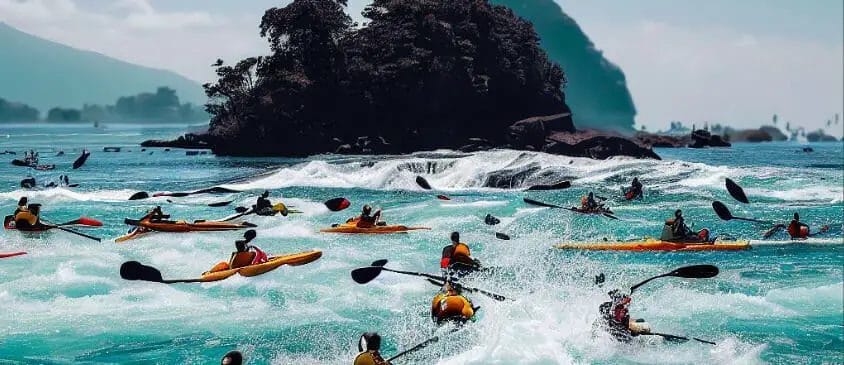
1. Olympic Kayaking
The pinnacle of competitive kayaking, both sprint and slalom disciplines, has been a part of the Summer Olympic Games for decades. Sprint kayaking debuted at the 1936 Berlin Games, and slalom was introduced at the 1972 Munich Games, albeit with a hiatus until it returned permanently in 1992.
Olympic Kayaking draws the world’s top athletes, all vying for the honor of Olympic gold. The fierce competition, the standards exceptionally high, and the race courses designed to challenge even the most seasoned paddlers. Both individual and team events are held, with races for men and women in various kayak (K1, K2, K4) and canoe (C1, C2) categories.
2. ICF Canoe Sprint World Championships
The International Canoe Federation (ICF) organized the Canoe Sprint World Championships, another prestigious global event attracting top-tier sprint kayaking talent. It has been held annually since 1970 (except for the Olympic years).
The event includes races in various classes and distances, with kayak and canoe divisions. The athletes compete for personal glory and national pride, representing their countries internationally.
3. The Devizes to Westminster International Canoe Marathon
Often called the “DW,” this marathon is a true endurance test. The race takes place in the United Kingdom, spanning 125 miles (201 kilometers) from Devizes in Wiltshire to Westminster in central London.
The race is not for the faint-hearted. It involves numerous portages around locks and weirs, and many competitors choose to complete the race non-stop, often paddling through the night. The event draws a diverse range of paddlers, from professional athletes to ambitious amateurs, all drawn to the challenge of this epic journey.
4. The Adidas Sickline Extreme Kayak World Championship
The Sickline Championship, held annually on the Ötztaler Ache River in Austria, is considered the ultimate challenge in extreme kayaking. It brings together the world’s best whitewater, slalom, and freestyle paddlers, competing on one of the most challenging whitewater courses.
The race course, known as the “Wellerbrücke” rapids, is a section of whitewater renowned for its demanding and technical nature. The competition combines a time-trial format with head-to-head racing in the later rounds, adding to the adrenaline and intensity of the event.
These competitions highlight the breadth and depth of kayaking as a sport—its grace and power, its combination of athleticism and artistry, and its ability to challenge and inspire.
Profiles of Top Kayak Athletes
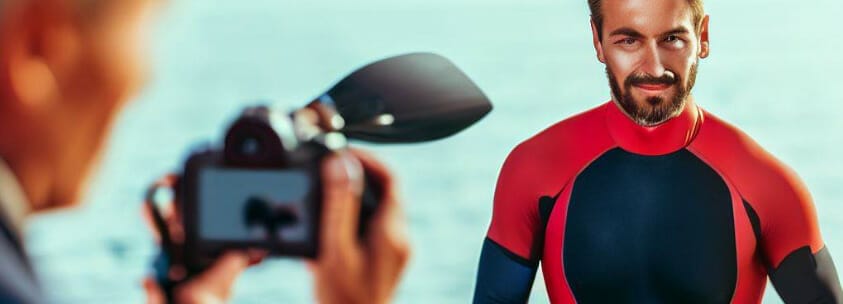
Let’s meet some of the most prominent athletes in the field, explore their key achievements, and discuss their unique techniques or styles.
A. Introduction to Prominent Athletes in the Field
- Lisa Carrington (New Zealand): A dominant force in women’s sprint kayaking, Carrington has numerous titles, including multiple World Championships and Olympic gold medals in the K1 200m.
- Adam van Koeverden (Canada): An outstanding sprint kayaker from Canada, van Koeverden has a distinguished career with multiple World Championships and four Olympic medals in K1 events.
- Jessica Fox (Australia): A slalom kayaker – both her parents are world champions in the sport – Fox has won numerous World Championships and has multiple Olympic medals to her credit in the K1 and C1 events.
- Erik Jackson (USA): A legendary figure in freestyle kayaking, Jackson has claimed multiple World Championships titles and has played a major role in popularizing the sport.
B. Key Achievements and Records Set
- Lisa Carrington: Carrington’s impressive career includes gold medals in the K1 200m at three consecutive Olympics (2012, 2016, 2020). She also set a world-best time in the event at the 2014 World Championships.
- Adam van Koeverden: Over his career, van Koeverden secured four Olympic medals, including gold in the K1 500m in 2004. He also holds multiple World Championships medals.
- Jessica Fox: Fox achieved a historic feat at the 2021 Tokyo Olympics by winning gold in the inaugural C1 women’s slalom event. She also holds the record for the most individual World Championships won canoe slalom.
- Erik Jackson: Jackson has won the ICF Canoe Freestyle World Championships four times. He is among the few to have won the title in the squirt boat and kayak disciplines.
C. Unique Techniques or Styles Employed
- Lisa Carrington: Carrington is renowned for her incredible power-to-weight ratio, explosive starts, and exceptional paddle technique. Her rhythm and pace are almost machine-like in their precision.
- Adam van Koeverden: Known for his impressive stamina and strategic race pacing, van Koeverden often used a high-stroke rate and powerful technique to outpace competitors.
- Jessica Fox: Fox stands out for her exceptional technical skills, agility, and precise boat control. Her ability to read whitewater and react quickly is unparalleled.
- Erik Jackson: Jackson’s freestyle routines showcase his creativity and control. He’s known for inventing new moves and pushing the limits of what’s possible in a kayak.
The Future of Kayak Competitions

As we look ahead, the future of kayak competitions appears bright and brimming with potential.
The sport continues to evolve, driven by new trends, upcoming competitions, and potential rule changes. Here’s what we might expect in the coming years:
Emerging Trends in the Sport
- Greater Inclusivity: Efforts are underway to make the sport more inclusive. For instance, the 2020 Tokyo Olympics marked the debut of women’s canoe slalom and sprint events, bringing gender parity to the Olympic canoe/kayak program. We expect to see more initiatives promoting diversity and inclusion in the sport.
- Rise of Extreme Kayaking: Extreme kayaking, which includes navigating fast, turbulent whitewater, is growing in popularity. It’s an adrenaline rush for the athletes and draws spectators and media attention, bringing new audiences to the sport.
- Technological Innovations: From advanced boat designs and materials to high-tech training aids, technology is significantly impacting the sport. We expect this trend to continue, with further advancements improving performance and safety.
B. Upcoming Important Competitions
- 2024 Summer Olympics (Paris): The Olympic Games will always be a key event in the kayaking calendar. With the sport gaining more attention and participants, the competition in Paris promises to be fiercely contested.
- Annual ICF World Championships: These events will remain a major focus for athletes, particularly in non-Olympic years. The sprint and slalom-disc championships offer a global stage for competitors.
C. Potential Rule Changes and Evolutions
- Adapting Competition Formats: To keep the sport engaging for spectators, there may be changes to competition formats. For example, we might see more head-to-head races or “super finals” with fewer competitors and higher stakes.
- Environmental Considerations: As with many sports, there’s growing awareness of the environmental impact of kayaking competitions. Future rule changes might involve stricter environmental regulations, such as limiting motorboat usage or requiring more sustainable materials for boats.
- Increased Safety Measures: Athlete safety remains paramount. We may see more rules or changes around equipment, course design, and emergency response to ensure that competitors are safe, especially in extreme kayaking events.
References
“Profile: Lisa Carrington.” International Canoe Federation. www.canoeicf.com/athlete/lisa-carrington.
“Profile: Adam van Koeverden.” Canadian Olympic Committee. www.olympic.ca/team-canada/adam-van-koeverden.
“Profile: Jessica Fox.” International Canoe Federation. www.canoeicf.com/athlete/jessica-fox.
“Advances in Kayak Technology.” British Canoeing. www.britishcanoeing.org.uk/guidance-resources/advances-in-kayak-technology.
“Paris 2024 Olympic Games.” Paris 2024. www.paris2024.org.
“2023 Canoe Slalom World Championships.” International Canoe Federation. www.canoeicf.com/canoe-slalom-world-championships.
